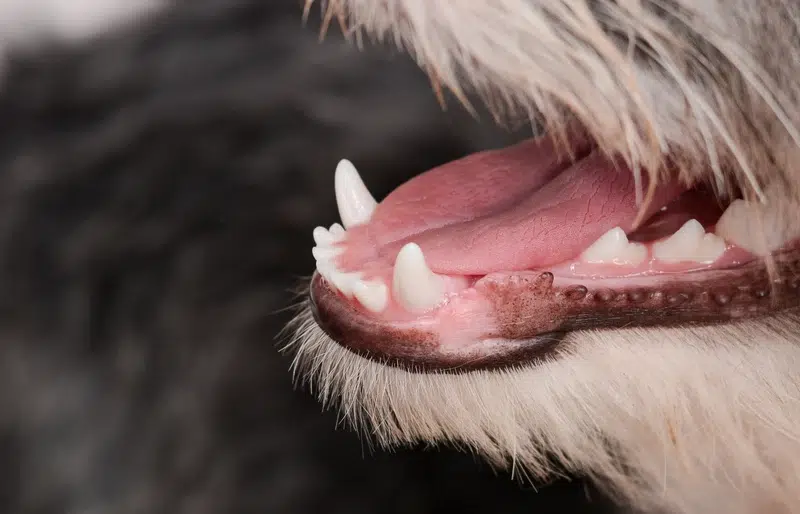Click to Skip Ahead
The term “rodent ulcer” sounds awful, doesn’t it? Thankfully, these ulcers have nothing to do with rats (or any rodent, for that matter). Additionally, they are neither life-threatening nor particularly uncomfortable, though they can be a bit of a nuisance. Rodent ulcers are red skin ulcers that typically appear on the lips and face of affected dogs. While these ulcers are fairly common in cats, they are somewhat rare in dogs.
Read on to find out what causes them, and what we can do to treat these lesions.
What Are Rodent Ulcers?
The technical term for a rodent ulcer is indolent ulcer or eosinophilic ulcer. These lesions form part of the eosinophilic granuloma complex in cats and dogs. This is a basket term for several different lesions, all believed to stem from allergies or “hypersensitivities”. Whether it’s fleas, food, or pollens, something is triggering an excessive immune response from affected pets. When seen in dogs, this disorder is typically associated with unusual reactions to insect bites or other hypersensitivity. They will often appear as bumps or nodules, in the mouth, on the lips, or anywhere on the body.
What about the name “rodent ulcer”? Farmers initially believed that the lesions appeared if their cat had been bitten by a rodent while hunting. We now know, however, that these ulcers have nothing whatsoever to do with rodents. The term is considered a misnomer and should also be avoided because it can be confused with rodent ulcers in people, which are a type of skin cancer.
Any dog breed may be affected, but Siberian Huskies and Cavalier King Charles Spaniels seem to be at greater risk.

What Are the Signs of Rodent Ulcers in Dogs?
Indolent ulcers usually develop on the lips, though they can also be seen on the tongue or even inside the mouth.
- Yellowish-pink spot on the upper lip (initially)
- Clearly defined, red, shiny sore on the lip
- Ulcers generally don’t bleed or ooze
- Non-painful to touch
- Loss of normal appearance of the lips (if severe)
- Secondary bacterial infections
A vet will be able to advise you on the best course of action to ensure the well-being of your pet.
If you need to speak with a vet but can’t get to one, head over to PangoVet. It’s an online service where you can talk to a vet online and get the personalized advice you need for your pet — all at an affordable price!
What Are the Causes of Rodent Ulcers in Dogs?
As we briefly touched upon, indolent ulcers are caused by allergies. Eosinophils are just one of the immune cells in the dog’s body (people have them too). Their main job is to seek out allergens and parasites, and to get rid of them before they cause issues. When an allergen is detected, the body sends out eosinophils.
In dogs, the allergen can be fleas, protein molecules in food, pollens in the environment, or even mold. While these things shouldn’t be perceived as a big threat, the body gets it wrong, and when eosinophils “over-react”, indolent ulcers form.

How Are Rodent Ulcers Treated?
Treatment should always start with a visit to your veterinarian. While indolent ulcers are fairly characteristic in their appearance, a number of other diseases can produce similar lesions. Ringworm, squamous cell carcinoma, fight wounds, and bacterial infections can all produce red lesions on the lips and face.
Treating indolent ulcers requires the underlying allergy to be addressed. Step one of this process is to ensure your dog has received a tick preventative. The next step is often a food elimination trial, to see if certain proteins are triggering the abnormal immune response. Testing for environmental allergies is also possible, though generally requires a specialist dermatologist.
Corticosteroids (available as tablet, liquid, or long-acting injection) are often used to suppress the excessive immune reaction. Some dogs may require antibiotics if secondary infections are present.
Frequently Asked Questions
What Is the Prognosis for Dogs with Rodent Ulcers?
Thankfully, the prognosis for dogs with indolent ulcers is good. These ulcers are not life-threatening, and they are also not painful. The vast majority of ulcers respond to treatment, especially if the underlying allergy can be identified.

How Are Rodent Ulcers Diagnosed?
Some vets will run basic in-house testing to be confident that the lesion is an eosinophilic ulcer. This involves taking samples for analysis under the microscope. If the ulcers are not responding to treatment, a biopsy can be performed under anesthetic to be certain that the lesion is an indolent ulcer. This involves surgically removing a piece of tissue to send for analysis at an external lab.
Are Rodent Ulcers Contagious?
No, indolent ulcers are not contagious. They do not spread from dog to dog, and humans cannot contract feline indolent ulcers.
Conclusion
While not correlated in any way to rats or mice, rodent ulcers can be a nuisance if left untreated. The key to treating and preventing their occurrence is to control the underlying allergy, though this can be tricky.
If you’ve noticed a lesion on your dog’s lip, even if it is small and does not appear uncomfortable, seek prompt veterinary care. The earlier indolent ulcers are treated, the faster they’ll go away.
Featured Image Credit: YAKOBCHUK VIACHESLAV, Shutterstock













